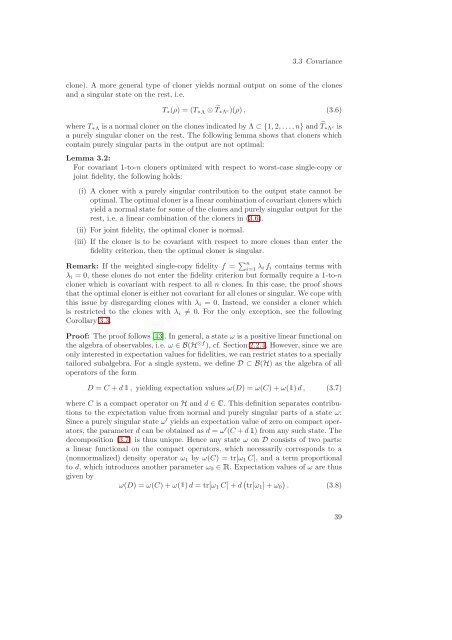Quantum Information Theory with Gaussian Systems
Quantum Information Theory with Gaussian Systems
Quantum Information Theory with Gaussian Systems
You also want an ePaper? Increase the reach of your titles
YUMPU automatically turns print PDFs into web optimized ePapers that Google loves.
3.3 Covariance<br />
clone). A more general type of cloner yields normal output on some of the clones<br />
and a singular state on the rest, i.e.<br />
T∗(ρ) = (T∗Λ ⊗ T∗Λc)(ρ), (3.6)<br />
where T∗Λ is a normal cloner on the clones indicated by Λ ⊂ {1, 2, . . ., n} and T∗Λc is<br />
a purely singular cloner on the rest. The following lemma shows that cloners which<br />
contain purely singular parts in the output are not optimal:<br />
Lemma 3.2:<br />
For covariant 1-to-n cloners optimized <strong>with</strong> respect to worst-case single-copy or<br />
joint fidelity, the following holds:<br />
(i) A cloner <strong>with</strong> a purely singular contribution to the output state cannot be<br />
optimal. The optimal cloner is a linear combination of covariant cloners which<br />
yield a normal state for some of the clones and purely singular output for the<br />
rest, i.e. a linear combination of the cloners in (3.6).<br />
(ii) For joint fidelity, the optimal cloner is normal.<br />
(iii) If the cloner is to be covariant <strong>with</strong> respect to more clones than enter the<br />
fidelity criterion, then the optimal cloner is singular.<br />
Remark: If the weighted single-copy fidelity f = n<br />
i=1 λi fi contains terms <strong>with</strong><br />
λi = 0, these clones do not enter the fidelity criterion but formally require a 1-to-n<br />
cloner which is covariant <strong>with</strong> respect to all n clones. In this case, the proof shows<br />
that the optimal cloner is either not covariant for all clones or singular. We cope <strong>with</strong><br />
this issue by disregarding clones <strong>with</strong> λi = 0. Instead, we consider a cloner which<br />
is restricted to the clones <strong>with</strong> λi = 0. For the only exception, see the following<br />
Corollary 3.3.<br />
Proof: The proof follows [43]. In general, a state ω is a positive linear functional on<br />
the algebra of observables, i.e. ω ∈ B(H ⊗f ), cf. Section 2.2.4. However, since we are<br />
only interested in expectation values for fidelities, we can restrict states to a specially<br />
tailored subalgebra. For a single system, we define D ⊂ B(H) as the algebra of all<br />
operators of the form<br />
D = C + d , yielding expectation values ω(D) = ω(C) + ω( )d, (3.7)<br />
where C is a compact operator on H and d ∈. This definition separates contributions<br />
to the expectation value from normal and purely singular parts of a state ω:<br />
Since a purely singular state ω ′ yields an expectation value of zero on compact operators,<br />
the parameter d can be obtained as d = ω ′ (C + d ) from any such state. The<br />
decomposition (3.7) is thus unique. Hence any state ω on D consists of two parts:<br />
a linear functional on the compact operators, which necessarily corresponds to a<br />
(nonnormalized) density operator ω1 by ω(C) = tr[ω1 C], and a term proportional<br />
to d, which introduces another parameter ω0 ∈Ê. Expectation values of ω are thus<br />
given by<br />
ω(D) = ω(C) + ω( )d = tr[ω1 C] + d <br />
tr[ω1] + ω0 . (3.8)<br />
39
















